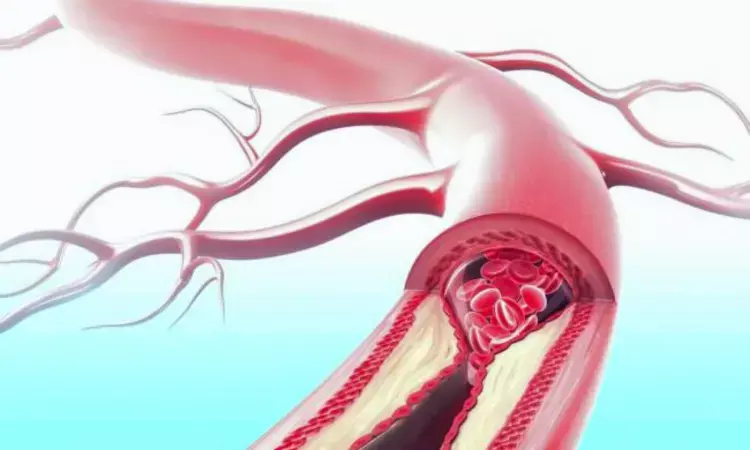- Home
- Medical news & Guidelines
- Anesthesiology
- Cardiology and CTVS
- Critical Care
- Dentistry
- Dermatology
- Diabetes and Endocrinology
- ENT
- Gastroenterology
- Medicine
- Nephrology
- Neurology
- Obstretics-Gynaecology
- Oncology
- Ophthalmology
- Orthopaedics
- Pediatrics-Neonatology
- Psychiatry
- Pulmonology
- Radiology
- Surgery
- Urology
- Laboratory Medicine
- Diet
- Nursing
- Paramedical
- Physiotherapy
- Health news
- Fact Check
- Bone Health Fact Check
- Brain Health Fact Check
- Cancer Related Fact Check
- Child Care Fact Check
- Dental and oral health fact check
- Diabetes and metabolic health fact check
- Diet and Nutrition Fact Check
- Eye and ENT Care Fact Check
- Fitness fact check
- Gut health fact check
- Heart health fact check
- Kidney health fact check
- Medical education fact check
- Men's health fact check
- Respiratory fact check
- Skin and hair care fact check
- Vaccine and Immunization fact check
- Women's health fact check
- AYUSH
- State News
- Andaman and Nicobar Islands
- Andhra Pradesh
- Arunachal Pradesh
- Assam
- Bihar
- Chandigarh
- Chattisgarh
- Dadra and Nagar Haveli
- Daman and Diu
- Delhi
- Goa
- Gujarat
- Haryana
- Himachal Pradesh
- Jammu & Kashmir
- Jharkhand
- Karnataka
- Kerala
- Ladakh
- Lakshadweep
- Madhya Pradesh
- Maharashtra
- Manipur
- Meghalaya
- Mizoram
- Nagaland
- Odisha
- Puducherry
- Punjab
- Rajasthan
- Sikkim
- Tamil Nadu
- Telangana
- Tripura
- Uttar Pradesh
- Uttrakhand
- West Bengal
- Medical Education
- Industry
OCT-FLIm Imaging Proven Safe and Feasible for Identifying High-Risk Atheromas: JAMA

South Korea: Researchers have found in a diagnostic feasibility study that OCT-FLIm structural-molecular intracoronary imaging is clinically safe and effective for the detailed characterization of human atheromas, highlighting its potential in diagnosing and understanding high-risk plaques.
The first-in-human clinical study, published in JAMA Cardiology, evaluated a dual-modal imaging technique that integrates fluorescence lifetime imaging (FLIm) with optical coherence tomography (OCT). This novel imaging platform offers the advantage of combining structural insights from OCT with biochemical profiling enabled by FLIm, aiming to provide a comprehensive picture of coronary plaque characteristics.
Conducted between February and August 2022 at a single center, the prospective, open-label trial enrolled 40 patients with significant coronary artery disease (CAD) undergoing revascularization procedures. The study included an equal distribution of patients presenting with acute coronary syndrome (ACS) and chronic stable angina (CSA).
Using specially designed 2.6-F OCT-FLIm catheters, Sunwon Kim, Department of Cardiology, Korea University Ansan Hospital, Ansan, South Korea, and colleagues imaged both culprit and nonculprit coronary lesions during routine procedures. The imaging protocol also included intravascular ultrasound for comparative analysis. The primary goal was to assess FLIm-derived molecular signals specific to different plaque components, such as macrophages, healed plaques, superficial calcification, and fibrosis. A secondary aim involved evaluating the technique’s ability to distinguish disease activity patterns—namely, ACS vs CSA and segments showing rapid angiographic progression vs stable plaques.
The study led to the following findings:
- The OCT-FLIm system effectively captured both microstructural and molecular characteristics of coronary plaques.
- OCT provided detailed structural imaging, while FLIm accurately identified the biochemical features of the plaques.
- Fluorescence lifetime (FL) values obtained using FLIm closely matched histopathological data from previous autopsy studies, reinforcing the technique’s reliability.
- Inflammatory markers—signifying high-risk or vulnerable plaques—were significantly elevated in patients with acute coronary syndrome (ACS) compared to those with chronic stable angina (CSA).
- The average FL value for inflammation was 7.59 nanoseconds in ACS patients versus 6.46 nanoseconds in CSA patients.
- Healed plaque features were more commonly found in coronary segments with rapidly progressing disease.
- These rapidly progressive plaques had a mean FL value of 5.31 nanoseconds compared to 4.81 nanoseconds in nonprogressive segments.
- The imaging procedure was safely completed in all 40 patients, with no reported adverse clinical events, confirming its strong safety profile for intracoronary application.
The authors concluded that OCT-FLIm offers a clinically viable and safe approach for the dual characterization of coronary plaques, providing both structural and molecular data. This imaging technology holds promise for refining diagnostic accuracy, guiding treatment decisions, and advancing the biological understanding of high-risk coronary artery disease. As cardiovascular imaging evolves, tools like OCT-FLIm may pave the way for more targeted and personalized patient care.
Reference:
Kim S, Nam HS, Kang DO, et al. Intracoronary Structural-Molecular Imaging for Multitargeted Characterization of High-Risk Plaque: First-in-Human OCT-FLIm. JAMA Cardiol. Published online May 07, 2025. doi:10.1001/jamacardio.2025.0928
Dr Prem Aggarwal, (MD Medicine, DNB Medicine, DNB Cardiology) is a Cardiologist by profession and also the Co-founder and Chairman of Medical Dialogues. He focuses on news and perspectives about cardiology, and medicine related developments at Medical Dialogues. He can be reached out at drprem@medicaldialogues.in


